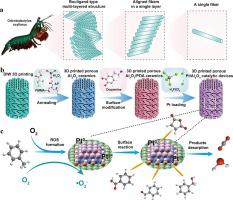Chemical Engineering Journal ( IF 13.3 ) Pub Date : 2023-08-16 , DOI: 10.1016/j.cej.2023.145504
Xin Xu , Bo He , Yixian Wang , Yuntai Xi , Desheng Liu , Zhongying Ji , Lichun Bai , Fang Dong , Zhibin Lu , Xiaolong Wang

|
Bouligand structure composed of twist-aligned nanofiber lamina as one typical biological skeleton is widely presented in various organism. Inspired by this, a strategy was proposed by coupling a novel method of 3D printing with surface modification, attempting to build the programmable helicoidal catalytic ceramics and then improving the catalytic performance. In this work, the biomimetic Bouligand architectures with different pitch angles (α), where the pitch angle is defined as the rotational angle of two adjacent twisted layer filaments, were built. Typically, the construction of bioinspired helicoidal catalytic ceramics with Bouligand structure can be divided into two steps, including the 3D printing of unidirectionally aligning ceramic filaments helical stacked helicoidal Al2O3 ceramics, and the surface functionalization of platinum (Pt) catalysts. To this end, we designed and fabricated several helicoidal catalytic ceramics with pitch angles (α) of 30°, 45°, 60°, and 90° for exploring the catalytic performances of toluene vapor, and the acquired corresponding toluene conversions at 200 °C were 92.51%, 92.46%, 90.67%, and 78.51%, respectively. Furthermore, as an optimal twisted helicoidal catalytic ceramic device rotated from 0° to 180° with a pitch angle of 30°, the conversion of toluene at 200 °C can reach 95.52%, and exhibited excellent catalytic activity, favorable repeatability, and superior water resistance in the process of toluene oxidation. Thus, the prepared helicoidal catalytic ceramic was employed to transform the airflow direction, thereby prolonging the contact time between the gas and the catalyst for improving the catalytic efficiency. Overall, the simple yet efficient method for achieving tailored catalytic performance by controlling the pitch angles, dimensions, as well as the structural motifs, that can provide valuable ideas and revelations for developing light-structure catalytic materials in the future.
中文翻译:

Bouligand 结构 3D 打印陶瓷的催化氧化性能
由扭曲排列的纳米纤维层组成的 Bouligand 结构作为一种典型的生物骨架广泛存在于各种生物体中。受此启发,提出了一种策略,将3D打印与表面改性相结合,尝试构建可编程螺旋催化陶瓷,进而提高催化性能。在这项工作中,构建了具有不同螺距角(α)的仿生 Bouligand 架构,其中螺距角定义为两个相邻扭曲层细丝的旋转角。通常,具有 Bouligand 结构的仿生螺旋催化陶瓷的构建可分为两个步骤,包括 3D 打印单向排列陶瓷丝螺旋堆叠螺旋 Al 2 O 3陶瓷和铂(Pt)催化剂的表面功能化。为此,我们设计并制造了几种螺距角(α)为30°、45°、60°和90°的螺旋催化陶瓷,用于探索甲苯蒸气的催化性能,并获得了相应的甲苯在200℃下的转化率分别为 92.51%、92.46%、90.67%、78.51%。此外,最佳的扭转螺旋催化陶瓷装置从0°旋转到180°,螺距角为30°,在200°C时甲苯的转化率可达95.52%,并表现出优异的催化活性、良好的重复性和优异的水产率。甲苯氧化过程中的抵抗力。因此,采用制备的螺旋催化陶瓷来改变气流方向,从而延长气体与催化剂的接触时间,提高催化效率。总的来说,通过控制螺距角、尺寸以及结构图案来实现定制催化性能的简单而有效的方法,可以为未来开发轻结构催化材料提供有价值的想法和启示。

































 京公网安备 11010802027423号
京公网安备 11010802027423号